
by Deep Green Resistance News Service | Mar 14, 2016 | Biodiversity & Habitat Destruction, Lobbying
Survival International has reported Italian engineering giant Salini to the OECD (Organization for Economic Cooperation and Development) over its construction of a controversial dam which is set to destroy the livelihoods of hundreds of thousands of people in Ethiopia and Kenya.
The dam has cut off the Omo river’s regular flooding, which 100,000 people rely on to water their crops and livestock and a further 100,000 depend on indirectly. According to experts, this could also spell the end for Lake Turkana – the world’s largest desert lake – and disaster for the 300,000 tribespeople living along its shores.
Salini did not seek the consent of local people before building the dam, but claimed that an “artificial flood release” would compensate them for their losses. However, this promised flood never came and thousands of people now face starvation.

Up to half a million people face starvation as a result of the dam Salini has constructed on the Omo river.
© Magda Rakita/Survival International
The region is one of the most important sites in early human evolution, and an area of exceptional biodiversity, with two World Heritage Sites and five national parks. The head of Kenya’s conservation agency said last week that the dam is unleashing “one of the worst environmental disasters you can imagine.”
Survival’s Director Stephen Corry said: “Salini has ignored crucial evidence, made false promises and ridden roughshod over the rights of hundreds of thousands of people. Thousands are now facing starvation because Italy’s largest contractor, and one of its best known companies, didn’t think human rights were worth its time. The real consequences of the Ethiopian government’s devastating policies for its country’s development, which are shamefully supported by western aid agencies like the UK’s DFID and USAID, are plain for all to see. Stealing people’s land and causing massive environmental destruction is not progress, it is a death sentence for tribal peoples.”
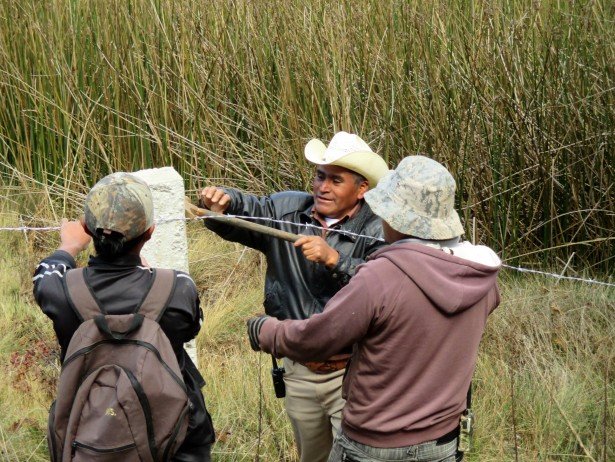
by Deep Green Resistance News Service | Feb 28, 2016 | Biodiversity & Habitat Destruction, Indirect Action
Featured image: Candelaria residents erect a fence around the Suyul Lagoon to help protect it from intruders. (Waging Nonviolence/Sandra Cuffe)
By Sandra Cuffe / Waging Nonviolence
The reeds and grasses are as tall as Sebastián Pérez Méndez, if not taller. The vegetation is so thick it’s hard to see the water in the Suyul Lagoon that he and other local Maya Tzotzil residents are working hard to protect. Pérez Méndez crosses the road to point out where aquatic plants serve as a natural filter for the water as it flows out the lagoon, located in the highlands of Chiapas, in southern Mexico.
“The water is under threat,” he said. Pérez Méndez is the top authority of the Candelaria ejido, a tract of communally-held land in the municipality of San Cristóbal de las Casas. “We’re not going to allow it.”
Communities in Chiapas are organizing to protect the Suyul Lagoon and communal lands from a planned multi-lane highway between the city of San Cristóbal de las Casas and Palenque, where Mayan ruins are a popular tourist destination. Candelaria residents continue to take action locally to protect the lagoon. They also traveled from community to community along the proposed highway route, forming a united movement opposing the project.
It all started back in 2014 when government officials showed up in Candelaria looking for ejido authorities, including Pérez Méndez’ predecessor. It was the first residents had heard about plans for the highway. The indigenous inhabitants had not been consulted and were not shown detailed plans.
“They realized that [the government officials] were only seeking signatures,” Pérez Méndez said.
No one person or group is authorized to make a decision that would affect ejido lands, however, and there are strict conditions in place to ensure elected ejido leaders are accountable to members, he explained. An extraordinary assembly was held to discuss the highway project.
The Candelaria ejido was established in 1935, a year after a new agrarian law enacted during the Lázaro Cárdenas administration led to widespread land reform throughout Mexico. More than 2,000 people live in the 1,600-hectare ejido, and more than 800 of them are ejidatarios — legally recognized communal land holders whose rights have been passed down for generations. Only ejidatarios as a whole have the power to make decisions on issues like the highway project.
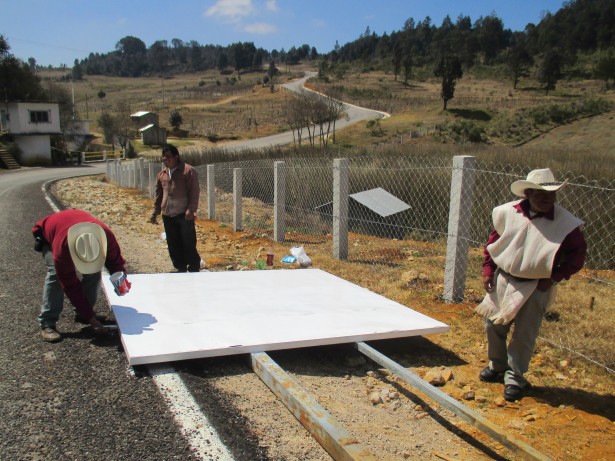
Candelaria residents paint over graffiti to fix up a roadside sign proclaiming their opposition to the highway project. (Waging Nonviolence/Sandra Cuffe)
“The ejido said no,” said Guadalupe Moshan, who works for the Fray Bartolomé de Las Casas Human Rights Center, or FrayBa, supporting Candelaria and other communities in Chiapas. “They didn’t sign.”
Candelaria leaders sought assistance from FrayBa in 2014, after they were approached by government officials and pressured to sign a document indicating their consent to the highway project that would involve a 60-meter-wide easement through communally-held lands. Officials told community members that the highway was already approved and that they would be well compensated, but that there would consequences if they refused to sign, Moshan said.
“They told them they would suspend government programs and services,” she explained. In the days following the extraordinary ejido assembly rejecting the project, there was unusual activity in the area, according to Moshan. Helicopters flew over theejido, unknown individuals entered at night, and trees were marked, she said.
Protecting the Suyul Lagoon remains at the heart of Candelaria’s opposition to the planned highway. The lagoon provides potable water not only for Candelaria, but also for several nearby communities, said ejido council secretary Juan Octavio Gómez. Aside from the highway itself, project plans eventually shown to the community leaders include a proposed eco-tourism complex right next to the lagoon. That isn’t in the communities’ interest, Gómez explained.
“Water is life. We can’t live without it,” he said. “Without this lagoon, we don’t have another option for water.”
Fed by a natural spring, the Suyul Lagoon never runs dry. Local residents are careful to protect the water and lands in the ejido, where the majority of residents live from subsistence agriculture, sheep rearing and carpentry. They engage in community reforestation, but have plans to plant more trees, Gómez said.
The Suyul Lagoon is also sacred to local Maya Tzotzil. Ceremonies held every three years in its honor involve rituals, offerings, music and dance.
“It is said that it’s the navel of Mother Earth,” Pérez Méndez said.
Candelaria residents didn’t sit back and relax after rejecting the highway project in their extraordinary assembly. They have been organizing ever since. The Suyul Lagoon lies just outside the Candelaria ejido, but it belongs to ejidatarios by way of an agreement with the supportive land owner. Aside from the highway project and potential eco-tourism complex, the lagoon has caught the attention of companies, whose representatives have turned up in the area expressing interest in establishing a bottling plant.
It’s cold in February up in the highlands, but community members have been out all day, erecting a fence around the Suyul Lagoon to protect it from intruders. White fence posts are visible under the treeline across the sea of reeds. Like so many other local initiatives, fence materials are collectively financed by the ejido and the labor is all voluntary, communal work.
While residents continue stringing barbed wire from post to post, others take paintbrushes to one of their roadside signs. Locals have erected large signs next to roads in and around their ejido, announcing their opposition to the tourist highway.
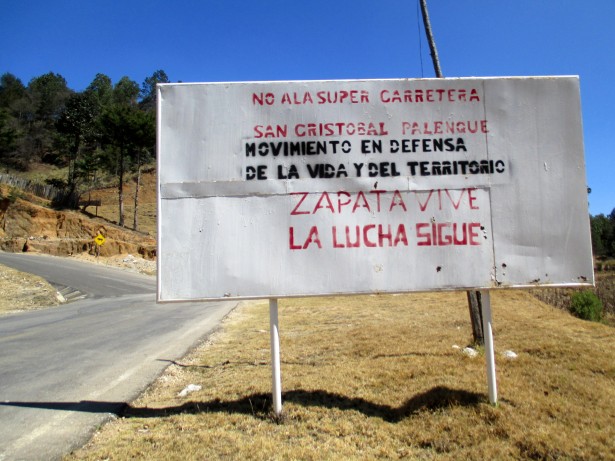
A sign along the road leading to Candelaria informs passers-by of opposition to the planned super-highway. (Waging Nonviolence/Sandra Cuffe)
“We’re also already organized with the other communities,” Pérez Méndez said. “All the communities reject the super-highway.”
After they were approached by government officials, Candelaria ejido residents traveled from community to community along the entire planned highway route. Some communities hadn’t heard of the project at all, while others said they were pressured into signing documents indicating their consent, Pérez Méndez said. As a result of Candelaria’s visits, community organizing along the highway route led to the formation of a united front of opposition, the Movement in Defense of Life and Territory.
Candelaria also recently got together with other indigenous communities in the highlands to issue a joint statement rejecting the tourist super-highway and a host of other government and corporate projects and policies.
“Our ancestors, our grandfathers and our grandmothers have always taken care of these blessed lands, and now it’s our turn to [not only take] care of the lands, but also to defend them,” reads the February 10 communiqué.
“The neoliberal capitalist system, in its ambition to exploit natural assets, invades our lands,” the statement continues. “The government and transnational companies are violently imposing their mega-projects.”
Back along the edge of the Suyul Lagoon, Candelaria residents continue to string barbed wire from post to post. They’ve been at it for a while now, according to Pérez Méndez, but they’ve now stepped up their efforts and hope to finish the fence by the end of the month.
Pérez Méndez surveys the progress, protected from the unrelenting sun and icy wind by his hat and white sheep’s wool tunic. He becomes pensive when asked if he thinks communities will be able to defeat the highway project.
“Yes,” the ejido leader said, after giving it some thought. “We can stop it.”
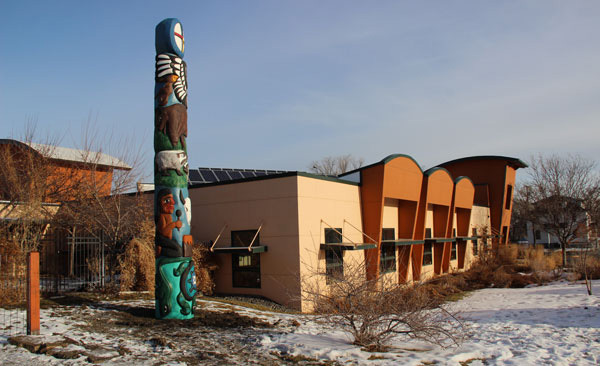
by Deep Green Resistance News Service | Jan 23, 2016 | Colonialism & Conquest
Featured image: The 22-foot western cedar totem pole, which features animals and symbols important to the Northern Cheyenne people was created by Master Carver and Lummi Elder Jewell James and the House of Tears carvers, of the Lummi Nation. The totem pole is a gift from the Lummi Nation to members of the Northern Cheyenne Tribe in southeast Montana as a symbol of solidarity between two tribes whose homelands are threatened by proposed coal export projects. A dedication ceremony for the totem pole was held on January 22, 2016, outside the Northern Plains Resource Council building in Billings, Montana, where the totem pole will stand until a more permanent home is found on the Northern Cheyenne Reservation. Photo courtesy of the Northern Plains Resource Council.
By Sandy Robson / Coal Stop
Author’s note: Today, one hundred and sixty-one years ago, the Treaty of Point Elliott was signed on January 22, 1855, by Isaac Stevens, then-Governor of Washington Territory, and by Duwamish Chief Seattle, Lummi Chief Chow-its-hoot, Snoqualmie Chief Patkanim, and other chiefs, subchiefs, and delegates of tribes, bands, and villages.

Elliott Treaty monument in Mukilteo, WA
In my endeavor to honor today’s 161st anniversary of the signing of the Treaty of Point Elliott, this piece brings attention to the disturbing fact that, presently, certain members of Congress are dishonoring that very same treaty as they seek to undermine it.
Treaty rights of the Lummi people are secured to them by the U.S. federal government in the Treaty of Point Elliott. Specific to treaty fishing rights, is Article 5 of the Treaty provides that, “The right of taking fish from usual and accustomed grounds and stations is further secured to said Indians in common with all citizens of the Territory. . .”
In determining whether Lummi Nation’s treaty-guaranteed rights of access to its usual and accustomed fishing grounds and stations, and harvest of fish, would be adversely impacted by the Gateway Pacific Terminal (GPT) project, a 48 million metric ton per year coal export terminal, the U.S. Army Corps of Engineers (“the Corps”) will be applying a de minimis threshold standard. Any impacts considered to be greater than de minimis by the Corps would warrant the GPT permit denial that Lummi Nation requested of the Corps back over a year ago, on January, 5, 2015.
Underneath the brief summary below of the legislative efforts of several members of Congress, is a detailed outline of the politicians; the campaign money, totaling over a quarter million dollars those politicians have received thus far; and the companies and projects, all relating to legislation that would diminish and undermine tribal treaty rights pertaining to proposed coal export projects in Washington state.
The Story
Congressional legislators who are backed by the coal industry and coal export terminal interests, have tried multiple times to attach a rider onto various bills that would undermine tribal treaty rights relating to the proposed Pacific Northwest coal export terminals. The original amendments proposed were specifically designed to try to prohibit the U.S. Army Corps of Engineers (“the Corps”) from making its determination regarding the Lummi Nation’s treaty fishing rights relating to the proposed Gateway Pacific Terminal at Xwe’chi’eXen (Cherry Point), before the final Environmental Impact Statement (EIS) would be completed for the project.
The language crafted in an amendment presently proposed by federal legislators, could adversely impact the treaty rights of all Indian Tribes and Indian Nations pertaining to projects such as GPT, or the Millennium Bulk Terminal, a 44 million metric ton per year coal export terminal proposed in Longview, Washington, both of which are presently under environmental review.
The fact that the Corps “owes the highest fiduciary duty to protect Indian contract rights as embodied by treaties” is entrenched in case law. That solemn duty and obligation owed to the Lummi Nation by the U.S. federal government, in this case by the Corps in relation to the GPT project, is something the agency addresses separately from any EIS it is tasked with on proposed projects.
In December, 2015, those multiple attempts to attach a rider which would undermine the Lummi Nation’s exercising of its treaty rights relating to the proposed Gateway Pacific Terminal (GPT) project, proved successful when Congressman David McKinley (R-W.Va.), and Congressman Ryan Zinke (R-MT), proposed Amendment 13, the “McKinley Amendment.” The amendment is attached to H.R. 8, the “North American Energy Security and Infrastructure Act of 2015.”
The “McKinley Amendment,” now designated Amendment 850, had originally been designated as Amendment 13 in the House. Amendment 13 was passed by the House on December 2, 2015, and then H.R. 8 was passed by the House the next day, on December 3, 2015.
Amendment 850, the “McKinley Amendment,” seeks to prohibit the denial of a permit for the construction, operation, or maintenance of an export facility until all reviews required under NEPA are complete.
 On December 7, 2015, H.R. 8 was received in the Senate and referred to the Committee on Energy and Natural Resources. The next step for H.R. 8 will be a hearing in the Senate.
On December 7, 2015, H.R. 8 was received in the Senate and referred to the Committee on Energy and Natural Resources. The next step for H.R. 8 will be a hearing in the Senate.
People should contact their U.S. senators to voice their opposition to Amendment 850, the “McKinley Amendment,” that is attached to H.R. 8.
Every day that passes as the Corps is making its decision on the fate of the GPT permit, is another opportunity for coal-backed legislators such as Congressmen McKinley and Zinke, and Senator Daines, to craft legislation aimed at diminishing Lummi Nation’s, and other tribes’ treaty rights.
Honor The Treaty. Now.
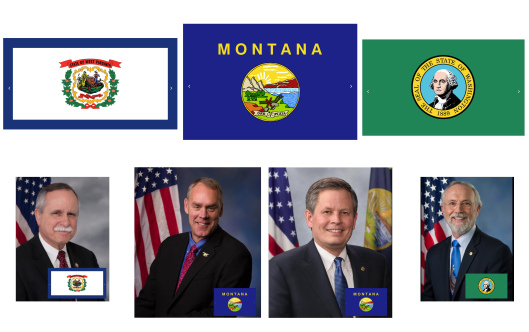
Top row, left to right: state flags of West Virginia, Montana, and Washington State. Bottom row, left to right: Congressman David McKinley (R-W.Va.), Congressman Ryan Zinke (R-MT), U.S. Senator Steve Daines (R-MT), Congressman Dan Newhouse (R-WA).
The Politicians
Congressman Ryan Zinke (R-MT) — Ryan Zinke, along with U.S. Senator Steve Daines, led a group of sixteen senators and seventeen members of the House in sending two July 28, 2015 letters (one from the Senate and one from the House) to the U.S. Army Corps of Engineers. The letters urged U.S. Assistant Secretary of the Army Jo-Ellen Darcy, to complete the environmental review process for the proposed GPT project prior to the Corps making a determination whether impacts to any tribes’ U&A (usual and accustomed) treaty fishing rights are more than de minimis, or too small or trivial to warrant legal review.
U.S. Senator Steve Daines (R-MT) — Senator Daines attempted multiple times, during the summer of 2015, to attach a specifically crafted amendment to various pieces of unrelated legislation. The amendments were specifically designed to try to prohibit the Corps from making its determination regarding the Lummi Nation’s treaty fishing rights relating to the proposed GPT, before the final Environmental Impact Statement (EIS) would be completed for the project. Daines ended up withdrawing his amendment. It is important to note that while Senator Daines orchestrates such efforts against the treaty rights of the Lummi Nation, he is a member of the Senate Committee on Indian Affairs.
Senator Daines, along with Congressman Zinke, led the group of sixteen senators and seventeen members of the House in sending the two July 28, 2015 letters mentioned above, to the U.S. Army Corps of Engineers.
Congressman David McKinley (R-W.Va.)— McKinley proposed Amendment 13 (now designated Amendment 850), the McKinley Amendment, which the House passed by a voice vote on December 2, 2015. Congressman Zinke co-sponsored that amendment.
Congressman Dan Newhouse (R-WA) – Dan Newhouse’s office was contacted about his position on Amendment 13 (now called Amendment 850) that was passed by the House on December 2, 2015, by a voice vote. Congressman Newhouse’s office staff responded “he supports that amendment, he supported it in the Rules Committee, and worked with McKinley and Daines on that.” Apparently, once again, Senator Daines has been involved in an attempt to undermine the treaty rights of the Lummi Nation, as he worked with Congressman McKinley on Amendment 850.
The Money
Congressman David McKinley (R-W.Va.), so far, has received the following campaign contributions relating to the proposed coal export terminals:
–$1,000 from FRS Capital for 2015-2016
–$3,500 from Arch Coal for 2015-2016
–$2,000 National Mining Association for 2015-2016
–$10,750 from Arch Coal for 2013-2014
–$5,000 from National Mining Association for 2013-2014
–$33,500 from Arch Coal for 2011-2012
–$10,000 from National Mining Association for 2011-2012
–$2,400 from Boich Companies for 2012 election cycle
Congressman Ryan Zinke (R-MT), so far, has received the following campaign contribution for the 2015-2016 election cycle relating to the proposed coal export terminals:
–$6,000 from FRS Capital Corp (ultimate parent company over Carrix and SSA Marine) for 2015-2016 election cycle
–$4,500 from Cloud Peak Energy (has 49% stake in PIT/GPT) for 2015-2016 election cycle
–$4,000 from Arch Coal for 2015-2016 election cycle
–$3,000 from National Mining Association for the 2015-2016 election cycle
–$17,700 from BNSF/Berkshire Hathaway for 2013-2016
Senator Steve Daines (R-MT), so far, has received the following campaign contributions relating to the proposed coal export terminals:
–$2,500 from FRS Capital Corp for the 2015-2016 election cycle
–$32,500 from Berkshire Hathaway for 2013-2016
–$26,400 from Boich Companies for 2013-2016
–$16,000 from Cloud Peak Energy for 2015-2016
–$11,500 from Arch Coal for 2013-2016
–$17,500 from National Mining Association for 2013-2016
Congressman Dan Newhouse (R-WA), so far, has received the following campaign contributions relating to the proposed coal export terminals:
–$6,000 from FRS Capital Corp (ultimate parent company over Carrix and SSA Marine) for the 2014 election cycle
–$2,500 from FRS Capital Corp/SSA Marine for the 2015-2016 election cycle
–$6,000 from Berkshire Hathaway (parent company over BNSF which would transport coal from WY and MT to the proposed Pac NW coal export terminals) for 2015-2016 election cycle
–$3,000 from Arch Coal for 2015-2016 election cycle
–$1,000 from National Mining Association for 2015-2016 election cycle
All of the campaign contributions listed above were obtained from the website, OpenSecrets.org.
The Companies and Proposed Projects
Gateway Pacific Terminal (GPT) — a proposed 48 million ton per coal export terminal at Cherry Point, in Whatcom County, Washington
Pacific International Terminals (PIT) — a subsidiary of SSA Marine and the applicant for the GPT project
SSA Marine — parent company over PIT
FRS Capital Corp — parent company over Carrix. Carrix is the parent company over SSA Marine
Cloud Peak Energy — presently has a 49% interest in PIT/GPT, and has an agreement with SSA Marine for an option to ship up to 17.6 million short tons of capacity per year through GPT
Arch Coal — in January, 2011, Arch Coal acquired a 38% equity interest in Millennium Bulk Terminals-Longview, LLC and its proposed Millennium Bulk Logistics Terminal. Arch Coal filed for Chapter 11 bankruptcy on January 11, 2016. Since Arch Coal filed for Chapter 11 bankruptcy, the stock has lost more than 80% of its value, and effective January 12, 2016, trading in Arch Coal common stock was suspended on the New York Stock Exchange
Millennium Bulk Terminals-Longview Coal Export Terminal — a proposed coal export terminal project to redevelop an operating bulk materials port on the Columbia River in Longview, Washington, for the export of 44 million metric tons of coal annually. The terminal is served by BNSF and Union Pacific railroads
Millennium Bulk Terminals-Longview, LLC (formerly Millennium Bulk Logistics) — a subsidiary of Australia-based Ambre Energy that was a majority (62%) partner in the Millennium Bulk Logistics Longview Terminal project (Arch Coal has a 38% interest). In November 2014, Ambre Energy sold its two Rocky Mountain coal mines and its stake in proposed coal export terminals planned for Washington and Oregon to Resource Capital Funds (a Denver, Colorado private equity firm) for $18 million, according to company filings with Australian regulators
Resource Capital Funds (RCF) is a long-established investor in Ambre Energy, maintaining a voting position on the company’s board, and loaning Ambre approximately $95 million. RCF bought the Decker mine in Montana, and the Black Butte mine in Wyoming, along with Ambre’s stake in the Morrow Pacific Project in Oregon and its stake in Millennium Bulk Logistics Longview Terminal in Washington
Ambre Energy had purchased Cloud Peak Energy’s 50% interest in Decker mine and related assets in September of 2014, and assumed 100% ownership of Decker Mine. Part of that deal included an option granted to Cloud Peak Energy for up to 7 million metric tonnes per year of throughput capacity at the proposed Millennium Bulk Logistics Longview Terminal, and Ambre Energy’s assumption of all reclamation and other Decker liabilities and replacement of Cloud Peak Energy’s $66.7 million in outstanding reclamation and lease bonds
Under the deal between RCF and Ambre Energy, RCF would operate under the name Ambre Energy North America, and the leadership team would stay the same. In April 2015, Ambre Energy North America changed its name to Lighthouse Resources Inc. Lighthouse Resources is a privately held company headquartered in Salt Lake City, Utah
BNSF Railway — applicant for the interrelated (to GPT) Custer Spur rail project and company that would transport coal from WY and MT to the proposed GPT and Millennium Bulk coal export terminals
Berkshire Hathaway — parent company over BNSF
Boich Companies — Boich Companies is a privately held coal mining and marketing company headquartered in Ohio, and is a joint-owner of Signal Peak Energy, LLC (Signal Peak Coal Mine) in Montana. Signal Peak Energy is jointly-owned by Boich Companies, FirstEnergy Corp., an Ohio-based utility company, and Pinesdale LLC, a wholly-owned subsidiary of Swiss commodity trader Gunvor Group, Ltd. The three partner companies formed an entity, Global Mining Holding Company LLC, to hold all the ownership interests. Global Mining Holding Company’s owners are FirstEnergy Ventures, a subsidiary of FirstEnergy; WMB Marketing, a Boich subsidiary; and Gunvor Group
Signal Peak Energy is a major exporter of coal, primarily to Asia, so it’s likely that Boich Companies is interested in getting a contract for shipping/exporting its Signal Peak coal to Asia through GPT in Whatcom County, WA. It is currently shipping coal through Westport Terminal in British Columbia. Signal Peak Energy is jointly-owned by Boich Companies, FirstEnergy Ventures (Ohio-based utility company), and Pinesdale LLC, a wholly-owned subsidiary of Swiss commodity trader Gunvor Group, Ltd.
Boich Companies is part owner Global Coal Sales Group which acquires coal mined at its affiliate Signal Peak Energy’s mine, from FirstEnergy Generation (a subsidiary of FirstEnergy Corp), and sells the coal in the international market. Global Coal Sales Group LLC, contributed $50,000 to the coal interest-funded Political Action Committee SaveWhatcom, during the 2013 Whatcom County election
National Mining Association (NMA) — is the national trade organization of the U.S. mining industry representing mining interests before Congress, the Administration, federal agencies, the judiciary, media, and the public. NMA also has at least two Political Action Committees.
Cloud Peak Energy, BNSF Railway, Peabody Energy, Millennium Bulk Terminals, Arch Coal, and Lighthouse Resources are listed members of the National Mining Association
Goldman Sachs — it was announced on July 5, 2007, that Goldman Sachs Infrastructure Partners committed to equity investment in Carrix (parent company over SSA Marine), giving Goldman Sachs Infrastructure Partners a 49% interest in Carrix). This funding was integral to the Gateway Pacific Terminal project. In January 2014, Goldman Sachs pulled out of the GPT project, selling its 49% interest back to SSA Marine.
by Deep Green Resistance News Service | Jan 18, 2016 | Indigenous Autonomy, Lobbying
By Glenn Scherer, Mongabay
Featured image: Brazilian President Dilma Rousseff visits the construction site of the Belo Monte Dam, 2014. Photo by Ichiro Guerra/Sala de Imprensa licensed under the Creative Commons Attribution-NonCommercial 2.0 Generic license
The gigantic Belo Monte hydroelectric dam, located on the Xingu River in the heart of the Brazilian Amazon, stood just weeks away from beginning operation this week — but the controversial mega-dam, the third largest on earth, has now been blocked from generating electricity by the Brazilian court system until its builders and the government meet previous commitments made to the region’s indigenous people.
Federal court judge Maria Carolina Valente do Carmo in the city of Altamira, in the state of Pará where the dam is located, has suspended the dam’s operating license. It will not be reinstated, she decided, until the dam’s owner Norte Energia SA, along with Brazil’s government, meet a 2014 court-ordered licensing requirement to reorganize the regional office of Funai, the national agency that protects Brazil’s indigenous groups.
Judge Valente do Carmo has fined the government and company R$900,000 (US$225,000) for non-compliance with the Funai requirement, a provision included in the rules governing Belo Monte when the project was given its preliminary license in 2010.
This is the latest in a series of snafus that have plagued the dam’s construction. Licensing of the project was delayed last September by Brazil’s environmental agency IBAMA, due to a failure to complete agreed to provisions to mitigate the impacts of inundating thousands of acres of Amazon rain forest — flooding that could displace 20,000 people.

Indigenous village near the Xingu River in the Amazon. Indigenous lands could soon be flooded by the Belo Monte dam. Photo by Pedro Biondi/ABr licensed under the Creative Commons Attribution 3.0 Brazil license.
Earlier in 2015, federal prosecutors found that Norte Energia violated 55 different obligations it had agreed to in order to guarantee the survival of indigenous groups, farmers and fishermen whose homes and lands will be lost.In December, Brazil’s Public Federal Ministry, an independent state body started legal proceedings to have it recognized that the crime of “ethnocide” was committed against seven indigenous groups during the building of the Belo Monte dam.
Indigenous groups have fought the dam since its inception, saying that it will severely impair their water supply and impact fishing and hunting. They especially contend that it will reduce the river’s flow by 80 percent at the Volta Grande (“Big Bend”), where indigenous Juruna and Arara people and sixteen other ethnic groups live, according to the teleSUR television network.
Partially republished with permission of Mongabay. Read the full article at Brazilian court suspends operating license for Belo Monte dam
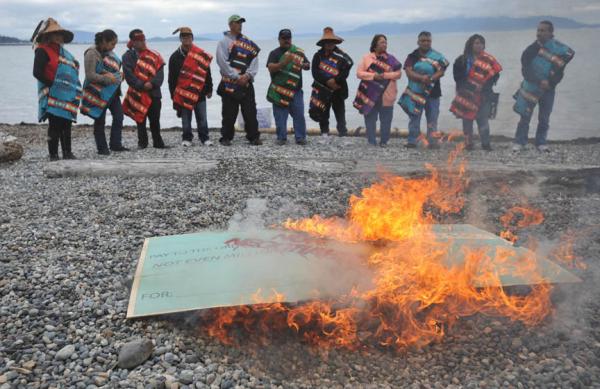
by Deep Green Resistance News Service | Jan 12, 2016 | Colonialism & Conquest, Indigenous Autonomy
Featured image: September 21, 2012: Members of the Lummi Nation protest the proposed coal export terminal at Cherry Point by burning a large check stamped “Non-Negotiable.” The tribe says they want to protect the natural and cultural heritage of the site. Photo by Indian Country Today Media Network.
By Sandy Robson / Coal Stop
The Lynden Tribune newspaper made the decision to publish a December 23, 2015 opinion piece submitted by Chair John Huntley and President Brad Owens of the Northwest Jobs Alliance (NWJA). The NWJA advocates for the proposed Gateway Pacific Terminal (GPT) project. Their op-ed leveled unsubstantiated, defamatory allegations at unnamed “leadership” of the Lummi Nation, a self-governing Indian Nation, and those allegations could easily be perceived as having been leveled at Lummi Nation as a whole.

Canoe and murals in the Lummi Administrative Building
The Lummi, a Coast Salish people, are the original inhabitants of Washington state’s northernmost coast and southern British Columbia. The Lummi Reservation is located in western Whatcom County, and it is governed by the Lummi Indian Business Council (LIBC), an eleven member tribal council.
 NWJA’s December 23, 2015 Lynden Tribune op-ed claimed that “the current leadership of the Lummi Nation has embarked upon a campaign against the working families of Whatcom County.” In an attempt to support that inflammatory claim, NWJA pointed to a December 10, 2015 letter from Kirk Vinish of the Lummi Nation’s Planning Department. However, a review of that 2-page letter produced no evidence to support such a claim.
NWJA’s December 23, 2015 Lynden Tribune op-ed claimed that “the current leadership of the Lummi Nation has embarked upon a campaign against the working families of Whatcom County.” In an attempt to support that inflammatory claim, NWJA pointed to a December 10, 2015 letter from Kirk Vinish of the Lummi Nation’s Planning Department. However, a review of that 2-page letter produced no evidence to support such a claim.
In contrast, NWJA has left a trail of evidence demonstrating its continued pattern of negative messaging to raise resentment about, and discredit, the Lummi Nation’s opposition to GPT by sending accusatory letters to the Army Corps and Whatcom County, and by disseminating similar accusatory messaging to the public, via the NWJA email list and a press release sent to local media.
In NWJA’s opinion piece, Huntley and Owens also alleged that Lummi Nation leaders are proposing the elimination of existing Cherry Point industry jobs. They provided no evidence whatsoever to support such a claim.

Excerpt from NWJA’s December 22 comment letter to the Whatcom County Planning Commission
As if it weren’t bad enough that NWJA submitted its defamatory op-ed for publication in a local newspaper, the Alliance launched a second strike aimed at Lummi Nation leadership the day before, by submitting a December 22 comment letter to the Whatcom County Planning Commission, on the currently ongoing Whatcom County Comprehensive Plan Update.
The comment letter was a slightly revised version of NWJA’s op-ed published in the Lynden Tribune, containing the same unsubstantiated accusations. NWJA’s inflammatory comment letter is now part of the official public comment record for the County Comprehensive Plan Update which the Whatcom County Council will review prior to voting on the final language to be included in the plan update. The fact that the Council is also one of the decision makers on permits needed by PIT for its GPT project makes NWJA’s comment letter “comprehensively” reprehensible.
GPT threatens Lummi treaty rights
GPT would be sited along the Salish Sea shoreline, at Xwe’chi’eXen, part of the Lummi Nation’s traditional fishing area. Xwe’chi’eXen is the Lummi peoples’ ancestral name for Cherry Point, an area which has a deep cultural, historic and spiritual significance to the Lummi people, as it was a village site for their ancestors for over 175 generations.
The projected coal export terminal threatens Lummi treaty rights, the salmon they depend on, their Schelangen (“Way of Life”), and the cultural integrity of Xwe’chi’eXen. LIBC Chairman Tim Ballew II sent a January 5, 2015 letter to the U.S. Army Corps of Engineers Seattle District Commander, Colonel John G. Buck, asking the agency to take immediate action to deny the GPT permit application.
In that letter, Chairman Ballew stated that the GPT project “will directly result in a substantial impairment of the treaty rights of the Lummi Nation throughout the Nation’s ‘usual and accustomed’ fishing areas.” Ballew also wrote that “The Lummi Nation is opposed to this project due to the cultural and spiritual significance of Xwe’chi’eXen, and intends to use all means necessary to protect it.” He added that the Lummi Nation has a sacred obligation to protect Xwe’chi’eXen based on that significance.

Page excerpt from “Protecting Treaty Rights, Sacred Places, and Lifeways: Coal vs. Communites,” presented by Jewell James, Lummi Tribal Member and Head Carver, Lummi Tribe’s House of Tears Carvers
The U.S. Army Corps of Engineers (“the Corps”) is the federal agency tasked with coordinating and handling the environmental review for the GPT project, and it is legally obligated to ensure that the Lummi Nation’s treaty rights are protected, and are not violated. Currently, the Corps is in the process of making a determination as to whether impacts to any tribes’ U&A (usual and accustomed) treaty fishing rights are more than de minimis, meaning too small or trivial to warrant legal review.

Article VI of the U.S. Constitution which includes the clause that establishes treaties made under its authority, are the supreme law of the land
SSA Marine consultant Craig Cole, Director for NWJA
The Northwest Jobs Alliance (NWJA) was created to promote and advocate for the GPT project. For the first few years, NWJA consisted solely of a Facebook page, after that page had been created in May of 2011. NWJA’s original mission statement that had been displayed for years on its Facebook page read: “The Alliance focuses their efforts on supporting the Gateway Pacific Terminal. . .” For almost three years, NWJA’s Facebook page showed “www.gatewaypacificterminal.com” as its website address, and the phone number displayed had been a non-working number.
Several articles appeared in Whatcom County citizen-based publications during the summer and fall of 2014, criticizing the legitimacy of the NWJA and likening it to a front group, as it did not have a working phone number or a website other than the official GPT website. Subsequently, NWJA made some changes. In fall of 2014, the NWJA added a working phone number, created a website for its online presence, and changed its listed website address on its Facebook page from “gatewaypacificterminal.com” to “NWJA.org.”
Presently, the NWJA website states the following as its mission: “The Northwest Jobs Alliance (NWJA) promotes the growth of family-wage jobs in the context of sound environmental practice.” Also, there is no mention of GPT on the NWJA website’s Home page where the organization’s mission and focus are explained. Instead the general term “Cherry Point industrial area” is used. On October 23, 2014, NWJA was filed as a non-profit corporation, according to the Washington Secretary of State website. SSA Marine’s paid local consultant for the GPT project, Bellingham resident Craig Cole, is the listed Director for NWJA.
On October 23, 2014, NWJA was filed as a non-profit corporation, according to the Washington Secretary of State website. SSA Marine’s paid local consultant for the GPT project, Bellingham resident Craig Cole, is the listed Director for NWJA.
 Since its inception, NWJA has had a steady turnover of co-chairs, all of whom have been very public advocates for the GPT project. Presently, Brad Owens is listed as NWJA President and John Huntley is listed as NWJA Chair. Huntley owns Mills Electric, a Bellingham electrical contracting company. Owens, a Bellingham resident, is the past President of the NW Washington Building & Construction Trades Council.
Since its inception, NWJA has had a steady turnover of co-chairs, all of whom have been very public advocates for the GPT project. Presently, Brad Owens is listed as NWJA President and John Huntley is listed as NWJA Chair. Huntley owns Mills Electric, a Bellingham electrical contracting company. Owens, a Bellingham resident, is the past President of the NW Washington Building & Construction Trades Council.
Some people confuse the “Northwest Jobs Alliance” for another similarly titled GPT advocacy organization called the “Alliance for Northwest Jobs and Exports.” It’s worthwhile to distinguish between the two, although promoting the GPT project has been the central intended purpose of both groups.
Cloud Peak Energy and BNSF govern Alliance for NW Jobs & Exports
The Alliance for Northwest Jobs and Exports (ANWJE) was first presented to the public as a grass-roots organization, when it was actually created in 2012, by Edelman, the world’s largest public relations firm, which was hired by SSA Marine to do public relations work for the proposed GPT project.
 According to the Washington Secretary of State website, ANWJE was filed as a non-profit corporationin July 2012. The “Governing Persons” listed are Todd O’Hair and Zak Andersen. Todd O’Hair is currently Senior Manager, Government Affairs for Cloud Peak Energy Inc. which has a 49% stake in SSA Marine/PIT’s GPT project. Zak Andersen is presently Assistant Vice President, Community and Public Affairs for BNSF Railway.
According to the Washington Secretary of State website, ANWJE was filed as a non-profit corporationin July 2012. The “Governing Persons” listed are Todd O’Hair and Zak Andersen. Todd O’Hair is currently Senior Manager, Government Affairs for Cloud Peak Energy Inc. which has a 49% stake in SSA Marine/PIT’s GPT project. Zak Andersen is presently Assistant Vice President, Community and Public Affairs for BNSF Railway.  BNSF is the applicant for GPT’s interrelated Custer Spur project and would be the railway transporting coal mined in Montana and Wyoming to GPT. ANWJE’s website describes its group as a “non-profit trade organization that supports new export projects in Oregon and Washington State…”
BNSF is the applicant for GPT’s interrelated Custer Spur project and would be the railway transporting coal mined in Montana and Wyoming to GPT. ANWJE’s website describes its group as a “non-profit trade organization that supports new export projects in Oregon and Washington State…”
BNSF Railway, SSA Marine, and Cloud Peak Energy are listed on the ANWJE’s membership list, which is comprised of companies and other entities which stand to benefit financially from the coal export terminal. So, this “non-profit trade organization” was created by the public relations firm hired by the GPT applicant, and it is governed by an employee of BNSF, the applicant for the interrelated Custer Spur project, and by an employee of Cloud Peak Energy, which has a 49% stake in SSA Marine/PIT’s GPT project.
NWJA’s attempt to drive public opinion against Lummi opposition to GPT
Whatcom Tea Party board member Kris Halterman hosts a local Whatcom County KGMI talk radio show, “Saturday Morning Live” (SML). On her September 12, 2015 SML show, Halterman hosted NWJA President Brad Owens, and together, they advanced an unsubstantiated, defamatory assertion that NWJA (the entity behind the Lynden Tribune op-ed) had previously purported in its August 20, 2015 letter to the Corps—that there is “an apparent motive behind the Lummi Nation’s opposition to the Gateway Pacific Terminal project (and completion of the EIS process)not connected with treaty rights.” [italicized emphasis theirs]
Joining in those activities against Lummi opposition to GPT, was the Political Action Committee SAVEWhatcom, headed up by Halterman, whose name pops up in most everything GPT-related. The SAVEWhatcom PAC was the vehicle for Gateway Pacific coal terminal interests to fund 2013 and 2014 local Whatcom County election political campaigns with over $160,000, which, if successful, would benefit those interests.

February 5, 2015 post from the SAVEWhatcom Facebook page
One month after the LIBC’s January 5, 2015 letter to the Corps, Halterman’s SAVEWhatcom placed a February 5 post on its Facebook page which disparaged the Lummi Nation and its Silver Reef Casino in what appeared to be an attempt to drive public opinion against the Lummi Nation’s strong oppositional stance to GPT.
Then, in an August 12, 2015 comment letter to the Whatcom County Planning Commission, NWJA seemed to pit “working families” who were characterized in the letter as “some of the very people who patronize Lummi enterprises”— against what was described as “tribal aspirations.” Echoing that previous tack of drawing attention to the Lummi Nation’s enterprises while at the same time denigrating the Nation with groundless claims, the NWJA referenced the Lummi Nation’s Silver Reef Casino in their December 23, 2015 Lynden Tribune op-ed. That excerpt read:
“And it saddens us to observe that the current leadership of the Lummi Nation has embarked upon a campaign against the working families of Whatcom County. These are some of the very families that patronize the Silver Reef Casino and other Lummi enterprises. Some thanks.”
Those specific repeated references to the Lummi Nation’s Silver Reef Casino and enterprises by SAVEWhatcom and the SSA Marine consultant-led NWJA, could be viewed as attempts to drive public opinion against the Lummi Nation’s Silver Reef enterprises—trying to change the minds of the Silver Reef’s loyal patrons who enjoy the hotel, spa, casino, entertainment/shows, multiple restaurants, convention and event venue, and more.
NWJA omits important statistics
NWJA’s December 23 opinion piece failed to mention that the Lummi Nation’s Silver Reef Hotel Casino & Spa employs 675 people. It also failed to mention any of the significant contributions from the Lummi Nation to Whatcom County’s community at large, which certainly have a positive impact on countless families and individuals in Whatcom County. For example, LIBC Chairman Tim Ballew stated in a May 2015 piece in The Bellingham Herald, that Lummi Nation was “humbled and honored to be able to give back to the people who work so hard to make our community thrive,” when referring to its Nation’s donations of over $600,000 awarded to 43 organizations. Some of those organizations include the Bellingham Food Bank, the Whatcom Literacy Council, and Whatcom County Fire District 8, to name a few.
NWJA stated in its December 23 op-ed and its December 22 comment letter to the County Planning Commission, that “Whatcom County ranks 30th out of 39 counties for personal income growth [Bellingham Herald 11/19/15].” In reading The Bellingham Herald article cited as a source for that statistic, NWJA did not bother to inform readers that while the per capita personal income average in Whatcom County increased 3.2% from 2013 to 2014, placing it 30th out of 39 counties in the state, Whatcom County’s 2014 per capita income total ranks 16th highest out of Washington’s 39 counties.

Excerpt from December 10, 2015 comment letter submitted to Whatcom County Planning and Development by the Lummi Nation Planning Department
In its December 23 op-ed, and in its December 22 comment letter NWJA sent to the Planning Commission, Huntley and Owens referenced specific language from the December 10, 2015 comment letter from Lummi Nation’s Planning Department submitted to Whatcom County Planning and Development. The specific language was a new policy that Lummi Nation recommended be added to the County Comprehensive Plan:
“The shipment of coal, or crude oil, from any new shipping terminal or pier, or any existing terminal or pier, is prohibited.” Huntley and Owens said they were troubled by the Lummi Nation’s recommendation and wrote:
“This echoes previous requests that the Lummi have made to the County to begin phasing out the Cherry Point heavy industrial zone.” No evidence, however, was provided by the NWJA to show any previous, or even current, requests from Lummi Nation to begin phasing out the Cherry Point heavy industrial zone.
The underbelly of their reasoning
One particular statement NWJA made in its August 12, 2015 comment letter to the County Planning Commission revealed the underbelly of their reasoning:
“The Lummi occupy an important and unique role in our community, but they are just 1.5% of the County’s population.”
NWJA repeated similar statements in its August 27, 2015 email advertisement disseminated via its mailing list, and in its September 10, 2015 press release, potentially indicating to their audiences a reason to marginalize and dismiss Lummi Nation’s voice based on the Lummi’s minority population status.
Just as “Manifest Destiny” mandated that it was supposedly God’s providence that the U.S. should exercise hegemony over its neighbors—seeing North America as the new Promised Land, NWJA and the GPT corporate interests they advocate for, seem to believe that it’s their economic providence to exercise hegemony over the Lummi Nation—seeing Xwe’chi’eXen (Cherry Point) and its naturally occurring deep-water contours which allow for huge Capesize vessels stuffed with U.S. coal bound for Asia, as their new Promised Land.
The Lummi Nation, however, and countless people in the Pacific Northwest region, have a very different view of their destiny, and that view does not include the transporting, handling, and shipping of 48 million metric tons per year of coal to Asia, which is the plan for GPT.
Raising resentment of tribal treaty rights; encouraging the public and government officials to ignore tribal treaty rights; calling into question the motivation behind an Indian Nation’s exercising of its tribal treaty rights; interfering with the federal regulatory review process and the government to government relationship between a U.S. federal agency and Indian Tribes and Indian Nations; and making disparaging and unsubstantiated accusations against an Indian Nation and its leaders, are some of the various ways in which the Lummi Nation is being attacked as powerful corporations endeavor to realize their perceived manifest destinies, in pursuit of a coal export terminal at Xwe’chi’eXen.






















